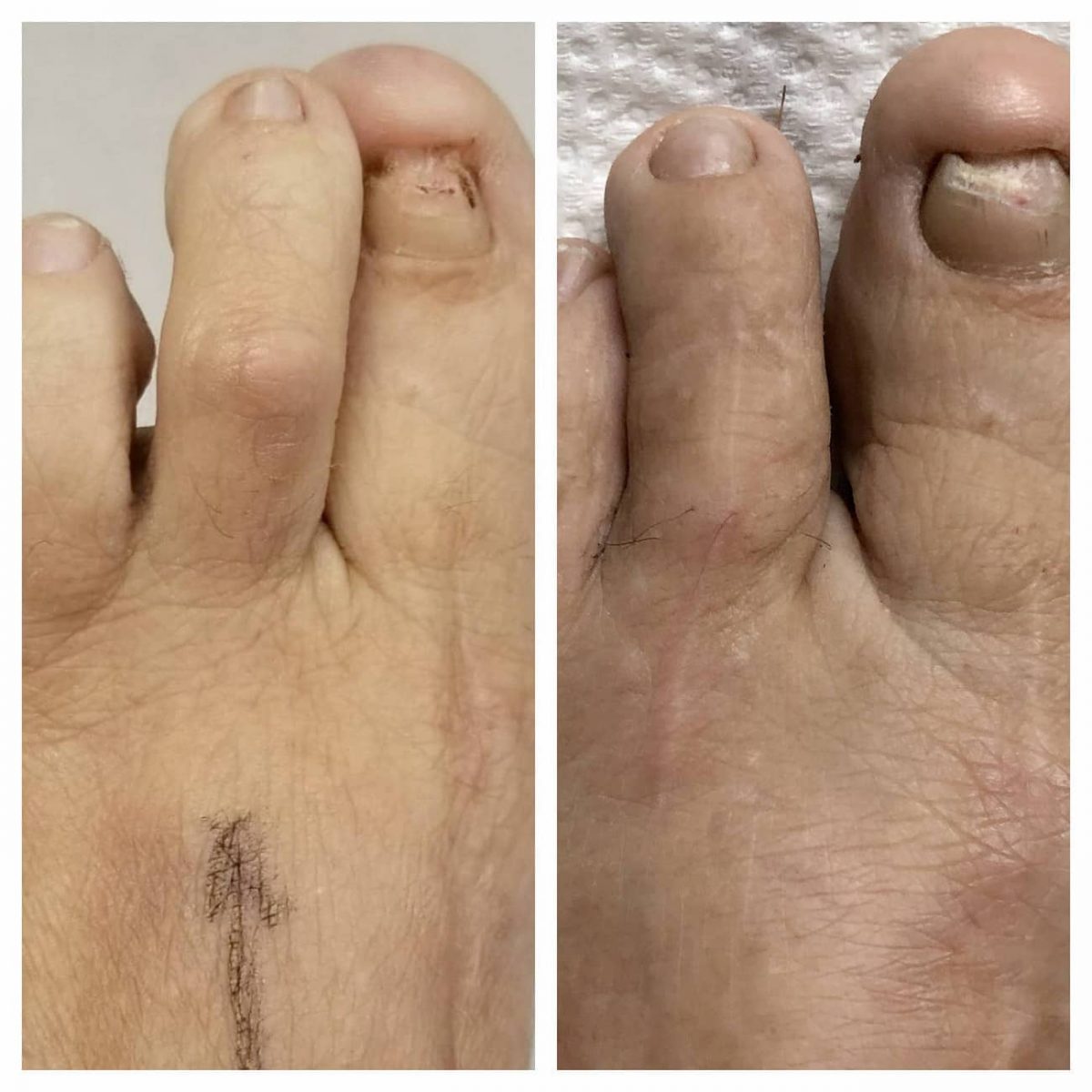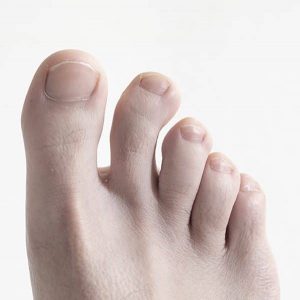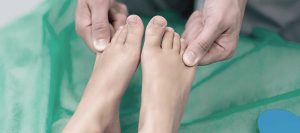
Toe straightening surgery is one of the most commonly performed by our foot and ankle specialists.
It involves the removal of a tiny piece of bone from the problematic joint, which straightens the toe and eliminates the buckling effect that so often accompanies this condition.
Some cases may require an artificial joint replacement, which may also include the repairing of damaged ligaments or the fusion of a particular joint so that it will become properly aligned with other toes.
What Causes The Need For Toe Straightening Surgery?
Many may believe that cosmetic foot surgery of any kind is performed solely because of vanity, but this is simply not so.

While it certainly is normal to want your feet to look and feel good, the motivation behind surgery most often concerns the severe discomfort that can arise from a crooked or misaligned toe.
Pain can be acute and arise sharply and unexpectedly during daily activities such as: walking or wearing a certain type of foot wear.
No matter what the reason for surgical correction may be, there is no longer any need for anyone to live with a crooked or misaligned toe
There are different types of procedures to correct and diverse causes leading to the development of misaligned or crooked toes.
It may be a congenital condition or occur later in life. A gait in which the feet roll inward while walking, although natural, may also cause toes to overlap one another.
Other culprits are bunions and flat feet, which can cause joint problems that can lead to toe misalignment. Crooked toes can also occur from an injury or aging.
The most common cause, however, is completely preventable; namely, the continuous use of shoes that are too tight and squeeze the toes together. Over time, this can and often does create significant toe damage.
Can Toe Misalignment Be Prevented?
There are a few practical measures that can help to prevent the formation of toe deformities. The South Florida experts at JAWS Podiatry recommend the following suggestions.
Always Buy Shoes That Fit Properly
Avoid shoes that fit too tightly, and put undue pressure on the feet.
This means women and loving wannabes should avoid stiletto heels except for maybe short-term use (a few hours) at special events, and opt instead for lower stacked varieties.
Equally important, both men and women should select shoes that allow enough space for all the toes to lie flat and spread out.
Foot Exercises
Learning how to stretch the muscles and tendons of toes can help strengthen them. One effective foot exercise concerns attempting to pick up small objects or using toes to crumple fabrics such as soft towels.
Toe spacing tools, which can be purchased over the counter, can help and are either worn with shoes or by themselves while you are sleeping.
Working with a physical therapist who can assign specific customized exercises can also be beneficial.
Toe Splints And Orthotics
These devices can successfully straighten and support toes. They provide relief and serve as buffers against toe overlapping or underlapping.
If a toe is flexible, the experts at JAWS Podiatry will often recommend the use of a splint, toe wrap or other device to keep the toe in a straightened position.
When Toe Straightening Surgery May Be Necessary
Once a toe has become rigid and permanently crooked, surgery may be the only avenue for correction.
This is especially true if there are concerns with mobility and significant pain. These procedures can be executed as stand alone or in tandem with bunion removal.
They are mostly performed under local anesthetic in less than an hour on an outpatient basis by the specialists at JAWS Podiatry.
A patient may feel some pressure or pulling during surgery, but no pain.
Following the procedure, there is likely to be some discomfort and the patient will need a driver to return home.
These surgeries require about two weeks recovery time in which the foot is placed in a splint.
For several weeks after that, a surgeon may recommend that the foot be placed inside a walking boot. For optimum results, patients should expect to take at least 1-4 weeks off from work, but it can be as much as 3 to 6 weeks or longer, depending on the kind of labor that is necessary, before one can expect to stand or walk for long periods.
It is often the big toe that begins to point toward others, which can cause the development of a bunion. Straightening it requires a special process known as an Osteotomy.
This involves realigning the toe by cutting into the metatarsal bone, which may ned to be fastened into place via pins, plates or screws during the recovery period.
Contact Our Teams At Jaws Podiatry!
This cutting-edge matrix for foot and ankle surgery center is situated in Hollywood, Florida and it is a godsend for those who live with lingering, debilitating foot pain.
At its helm is our very own Dr. Abraham Wagner, South Florida’s foremost and highly acclaimed Doctor of Podiatric Medicine (DPM). He and his dynamic staff specialize in procedures for patients living in Miami-Dade and Broward counties.
We also service patients who travel from all across the United and States and beyond to benefit from our impeccable skills and reputation.
As is the case with all professionals, surgery is always considered a last resort and those procedures performed by the staff at JAWS Podiatry are considered minimally invasive (MIS).
Services are manifold and they include: general foot care, treatment and therapy, foot and ankle surgical procedures, regenerative medicine and platelet rich plasma (PRP) therapy.
Our feet were made for walking, as go the lyrics of an old song, but when they hurt, there is absolutely nothing to sing about, and it’s time to contact our foot and ankle specialists at JAWS Podiatry! We’re always here to help!
Video Transcription
Welcome….Jaws Podiatry. We are in our office here and I think a lot of people will appreciate this idea because as everyone knows, I I don’t really post most of the surgeries, but today I will be posting some surgery. We have a young gentleman here who just literally flew in from New York. Here we have a really nice, robust program…
We are going to go ahead now and present the case, and in about two hours, he will be back in the airport and flying back to New York. So this patient has presented to me something that a lot of people battle with; an inflexible mallet toe. So there’s a big difference in respect to the presentation and history.
So we have the hammer toe, the classic, and the mallet, which is only the tip. So this patient has a really, really painful mallet toe and this is something not aesthetic but something functional. It means that there is associated pain. What we are going to do is called a… flexor phenomenon…
What we have are a few tendons, right? We have the flexor tendon on top and we have the extension. Okay? Now a lot of people ask the number one question: ‘Dr. Wagner, will I have a range of motion afterwards?’ This is a really great question.
You know, it’s a shame that sometimes we have to suffer, so if the mallet toe is like this (bent), in order for us to take it to this (straight), we have to sacrifice a tendon underneath, and that’s the tendon that basically does this (wiggles toe). There’s a lot of disparity involved…so it really depends on where you perform the surgery, but the patient will have a range of motion.
They may not be able to…as that depends on the patient, but he or she by now will be able to do this (wiggle toe), really, really flex the toe and move it up and down. And sometimes, what happens is the tendon really calms down a little bit around…We don’t want a conflict or a call saying: ‘Hey, Wagner, I have a problem. I can’t move my toe down. Is this normal?’ We do not want that….I think I have spoken enough…Bye bye.
- The Life-Changing Power of Cosmetic Foot Surgery - February 27, 2023
- What Are The Most Common Pediatric Foot Conditions? - October 5, 2020
- 4 Important Things To Know Before Having Foot Surgery - September 21, 2020



